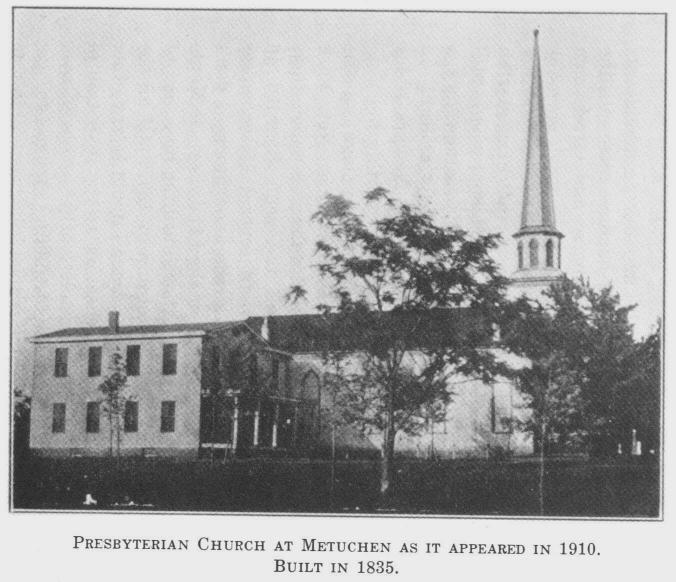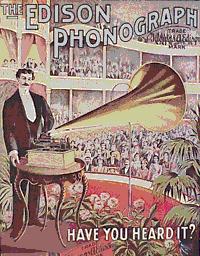
Metuchen Edison History Features
Recollections of
Boyhood Days
In Old Metuchen
By
David Trumbull Marshall
Published by The Case Publishing Co., Flushing NY 1930
(Second Edition)- (c) 1930
The Edison Phonograph.
When I was a boy in 1877, most of the inhabitants of Metuchen were New York business men with the usual number of storekeepers and tradesmen serving such a population.
My Father and Mother, with their seven children, lived at the Parsonage of the Presbyterian Church, the Minister, Rev. J. G. Mason, who is still the Pastor, boarding with us. My father kept a private school where he fitted boys for college. In 1876 Thomas A. Edison moved from Newark to his new Laboratory at Menlo Park.

Menlo Park is a very small village on the Pennsylvania Railroad two miles nearer New York than Metuchen. As there were few accommodations at Menlo Park many of the men boarded in Metuchen, while there were several Metuchenites who were also employed at the Laboratory. I don't remember hearing much of the Laboratory at Menlo Park or of the goings on there until the invention of the phonograph in the autumn of 1877. Of all the inventions that were ever made I doubt if any other ever produced such a sensation as the invention of the phonograph. The whole world went wild over it. Those who were fortunate enough to get possession of a machine reaped a harvest exhibiting it. The first machines consisted of a metal cylinder about six inches in diameter and about six inches long having a shallow groove cut spirally around its face. This cylinder was mounted horizontally on an axis and provided with a crank by means of which it might be turned by hand. A sheet of tin foil was wrapped around the cylinder and facing this there was a transmitter mounted on a threaded carrier. The transmitter being essentially the same as the one in use today. When the crank of the cylinder was turned and words were spoken against the diaphragm of the transmitter, the needle made dents in the tin foil.
When the transmitter was moved back to the place of beginning the needle being in contact with the row of dents, and the crank was turned, the voice was reproduced. The voice was loud and raucous to be sure, but it was a voice. To a world which up to that time had never heard the human voice reproduced by aught but an echo, the thing Was simply incredible. I remember afterward while working in the Laboratory at Orange, N. J., hearing Mr. Edison say that the phonograph was the only machine he ever made which worked the first time he tried it, and that he could hardly believe the evidence of his own senses when the thing actually spoke. One of our neighbors, who worked at the Laboratory, brought one of these phonographs to the Parsonage. Like most country churches our church was always giving entertainments to raise money. Then and there it was decided that we give an exhibition of the phonograph and of the recently invented telephone in our church. My father went to Menlo Park where he was very courteously received by Mr. Edison, who showed him the phonograph and loaned him one for use at our church.
Like many a small boy before and since, I sallied forth to pester the people in our neighbor hood into buying tickets for our entertainment. One old lady asked me, "What band of singers is this company of telephone singers?" evidently never having heard of the telephone. When the night of the concert arrived the church was jammed. My father gave a demonstration of the phonograph. When his voice came again from the machine the effect on the audience was wonderful.

An Edison loud-speaking chalk-cylinder telephone instrument had been set up on the platform. Cowles Andrus, a local tenor soloist, had been installed in a near-by building at the transmitter, there being about two miles of wire between the instruments. The voice could be heard all over the church, but much to the disgust of the small boys the words were indistinguishable. The chalk telephone consisted essentially of a cylinder of chalk about an inch in diameter mounted on a crank which could be turned by hand. When the cylinder was suitably moistened and set revolving, it so modified the electric impulses coming over the wire from the transmitter that vibrations were given off and sound produced. For several years after the invention of the first crude phonograph Mr. Edison was too busy with the electric light to do much with the phonograph. Later on when his new laboratory was established at Orange, (1889) he set to work on the phonograph and after several years of constant experimenting he perfected the Edison cylinder phonograph, which was later discarded for the more practical disc machine. Mr. Aylesworth, who worked at the table next to me in the Laboratory at Orange, tried endless mixtures of wax, gum, soap, resin and paste before the trail of the finally adopted mixture was struck.
The room where I worked at the Orange Laboratory was next to the one where Mr. Edison tried out the various phonograph cylinder mixtures.
Day after day, for months on end, I have heard Mr. Edison repeat his favorite test verse…
"The boast of heraldry,
the pomp of pow'r,
And all that beauty,
all that wealth e'er gave,
Await alike the inevitable hour;
The paths of glory lead but to the grave."
Boyhood Days in Old Metuchen Title page
Thomas Alva Edison in Menlo Park page
Metuchen Edison History Features index page
Metuchen Edison Historical Society page
Lasted updated 6/8/99 by Jim Halpin.